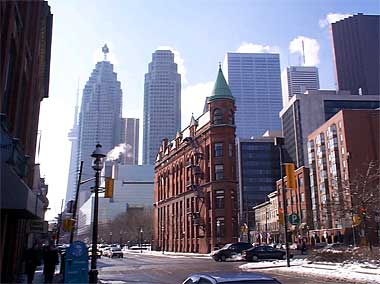Toronto - Origins of One of the Great Cities of the World
by Rick Hendershot
The cosmopolitan Canadian city of Toronto now has a population of more than three million and the most ethnically diverse culture in the world. But three hundred years ago it was little more than a portage where the Humber River flows into Lake Ontario. It was known only to local natives and a few French voyageurs.
White Man Meets Indian
The first settlers in the Toronto area were native North American Indians. Different tribes had inhabited the area around Lake Ontario for at least ten thousand years. By the time Europeans first started exploring the region, the predominant Indian tribes were the Hurons and Petuns.
During the 1600s the Indian populations of much of this part of North America were devastated by diseases brought to the new world by European explorers and settlers. As Indian tribes were reduced by disease, tribes feuded with each other for their very survival. Indeed, some tribes did not survive.
This was the state of affairs in the southern Ontario region for much of the 1600s as Iroquois battled with Hurons. By 1688 however the Iroguois, who had moved into the Toronto area, were in turn displaced by the French, and gradually the southern Ontario region was dominated by the white man.
The Early French Period
The first European to reach the Toronto area is thought to have been Etienne Brule, who had served under Samuel de Champlain. Tradition has it that Brule "discovered" the Toronto site in 1615, but other scholars question whether Brule ever reached Lake Ontario at Toronto.
The first verifiable evidence of European presence in the area came with Roman Catholic missionaries working with the local natives in the 1660s and 1670s. Seasonal traders also regularly passed through the area by this time, the most famous of whom was the explorer Rene-Robert Cavelier de La Salle.
By 1720 the French had established a trading post on the Humber River at the base of what was known as the "Toronto Passage." And in 1750-51, the French built Fort Rouille to protect French interests in the area against the British.
Fort Rouille, or Fort Toronto as it was more commonly known, was used as a trading post until 1759. At that time the French were locked in a protracted war with the British to decide which imperial power would have the upper hand in dividing up world wide colonial interests. The French were forced to retreat from much of inland North America in 1759. Before retreating from Fort Rouille they burned the fort to the ground rather than having it fall into English hands.
The British Take Over
This marked the end of French control of the regions we now know as Toronto and Ontario, and the beginning of English domination, which was formalized in 1763 with the Treaty of Paris.
During the following decades the fate of Toronto was largely decided by events taking place south of the great lakes in the American Colonies. In the late 1770s and throughout the 1780s much of southern Ontario was settled by United Empire Loyalists who were forced to flee from the newly independent American authorities. And, along with British settlers, missionaries, and governing elite the population and culture of the Toronto region slowly developed and grew.
The threat from an openly antagonistic United States was foremost on the minds of most residents of the British colonies to the north, and as a result, Toronto and the rest of southern Ontario experienced only slow growth for a number of decades.
In 1793 the Lieutenant-Governor of Upper Canada, John Graves Simcoe, moved the capital of the province from Newark (Niagara-on-the-Lake) to Toronto and renamed the town York. At that time it was still a very small town consisting of only about 50 families. In 1813 one of the most decisive events of the War of 1812 with the U.S. saw York captured by the Americans and many of its major buildings burned to the ground.
But in spite of the damage done to York, the War of 1812-14 represented the end of hostilities between the U.S. and British North America. As a result the Toronto and southern Ontario regions experienced accelerated immigration and much more rapid development throughout the 1800s.
Toronto Develops Along With Canada
In 1834 the name of York was changed back to Toronto, and in 1841 Toronto became the capital of the newly minted Canada West region of the United Province of Canada.
In 1867 when the Canadian confederation was reformed and expanded, Toronto carried on as the capital city of the new provice of Ontario.
Toronto's population grew rapidly in the late 1800s, with the population going from 30,000 in 1851 to 181,000 in 1891. This rapid population growth was almost completely the result of immigration. The 1891 population figure also included recent annexations of many smaller, outlying towns such as Parkdale, Brockton Village, West Toronto, East Toronto, and many others.
Most of the immigration in the early and mid 1800s was from Britain and Ireland. As a result Toronto became a thoroughly English-Scottish-Irish town and remained that way until immigration patterns changed in the late 1800s.
Source: http://www.articlecircle.com/ - Free Articles Directory
About the Author
Rick Hendershot publishes the Canada Travel Network - http://www.canada-travel-web.info
Article adapted from http://www.visit-toronto.com a great source of Toronto travel information, including information about Toronto wedding photographers - http://www.davide.cc |

